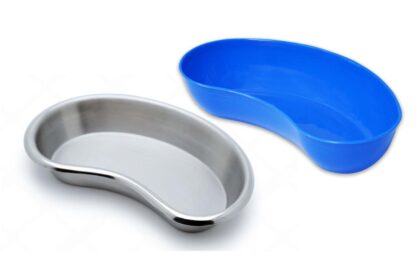
A kidney tray, also known as an emesis basin, is a shallow, curved container that resembles the shape of a kidney. It is commonly used in medical settings, including hospitals, clinics, and first aid environments, for various purposes such as:
Collecting Waste:
- Holding vomit, saliva, or other bodily fluids during medical procedures.
- Collecting soiled dressings, used bandages, or surgical waste.
Assisting with Patient Hygiene:
- Used when patients are bedridden or unable to use regular sanitary facilities.
- Assisting in oral care or as a container for rinsing during procedures.
Holding Tools:
- Temporary storage for small medical instruments like forceps, syringes, or gauze during procedures.
Administering Medications:
- Serving as a clean surface for mixing or preparing medications.
Design Features:
- Material: Typically made of stainless steel (durable and easy to sterilize) or disposable plastic.
- Shape: The kidney shape allows it to fit comfortably against the body, making it ergonomic for use under a patient’s chin or at their side.
- Size: Usually compact and lightweight, making it easy to handle and transport.
Types of Kidney Trays
Based on Material
Stainless Steel Kidney Trays:
A stainless steel kidney tray is a durable, reusable, and corrosion-resistant medical tray with a kidney-shaped design.
- Durable, reusable, and easy to sterilize.
- Commonly used in surgical and clinical settings.
Plastic Kidney Trays:
A plastic kidney tray is a lightweight, disposable, or reusable medical tray shaped like a kidney.
- Lightweight and often disposable.
- Suitable for single-use purposes or non-sterile environments.
Enamel Kidney Trays:
- Coated with enamel for ease of cleaning and durability.
- Less common today but used in some healthcare setups.
Silicone Kidney Trays:
- Flexible and soft, reducing the risk of injury.
- Often used in specific medical or pediatric applications.
Based on Size
Standard Size:
- Used for general-purpose tasks in most healthcare settings.
Large Size:
- Suitable for procedures requiring a larger volume of fluids or waste collection.
Small Size:
- Handy for minor procedures or bedside use.
Based on Use
Sterile Kidney Trays:
- Packaged and sterilized for use in surgical or invasive procedures.
Non-Sterile Kidney Trays:
- Used for general-purpose tasks like waste collection or patient hygiene.
Disposable Kidney Trays:
- Designed for single-use to reduce the risk of cross-contamination.
Autoclavable Kidney Trays:
- Made from materials like stainless steel or heat-resistant plastic that can withstand high temperatures for sterilization.
Specialized Types
Graduated Kidney Trays:
- Marked with measurement lines to track fluid volume accurately.
Custom-Fit Kidney Trays:
- Designed for specific medical equipment or uses, such as trays with unique sizes or shapes for surgical procedures.
Benefits of Kidney Trays
Kidney trays, also known as emesis basins, are shallow, kidney-shaped containers commonly used in medical settings. They offer numerous benefits for healthcare professionals and patients. Below are the detailed benefits of kidney trays:
Ergonomic and Practical Design
- The kidney shape is designed to fit comfortably against a patient’s body, making it easier to collect fluids, vomit, or medical waste without spillage.
- The curved edge allows for easy handling and placement against the mouth, under wounds, or during procedures.
Multi-Purpose Use
- Medical Waste Collection: Used for collecting vomit, blood, pus, and other bodily fluids.
- Dressing and Instrument Holder: Helps hold dressings, gauze, syringes, and other medical tools during procedures.
- Wound Care: Used for cleaning and dressing wounds efficiently.
- Dental Use: Helps collect saliva and other fluids during dental procedures.
Hygienic and Easy to Clean
- Stainless steel kidney trays are non-porous and easy to sterilize, preventing the spread of infections.
- Disposable plastic or paper-based trays provide a single-use option, reducing the risk of cross-contamination.
Durability and Material Options
Available in stainless steel, plastic, and disposable paper materials, catering to different needs:
- Stainless Steel: Highly durable, reusable, and resistant to corrosion.
- Plastic: Lightweight, cost-effective, and often used for short-term applications.
- Disposable Trays: Used in infection-control settings to eliminate the risk of contamination.
Cost-Effective and Space-Saving
- Stackable design allows for easy storage in hospitals and clinics.
- Reusable trays reduce long-term costs for healthcare facilities.
- Disposable trays help reduce cleaning and sterilization costs.
Improves Patient Comfort and Care
- Provides a convenient way to manage bodily fluids without causing discomfort.
- Ensures hygienic handling of vomit or blood, reducing distress for patients.
- Minimizes the risk of accidental spills, keeping the patient’s environment clean.
Essential in Emergency and Surgical Situations
- Used in emergency rooms, operating theaters, and ambulances for quick and efficient waste collection.
- Essential for bedridden patients who cannot move to a sink or bathroom easily.
Compliance with Medical Standards
- Designed to meet hospital infection control guidelines.
- Helps in maintaining sterile field protocols in surgical and medical settings.
Conclusion
Kidney trays are an essential medical tool offering versatility, hygiene, and convenience in various healthcare applications. Their ergonomic design, durability, and multiple uses make them indispensable in hospitals, clinics, and emergency care settings. Whether reusable or disposable, they enhance patient comfort and ensure efficient medical waste management.